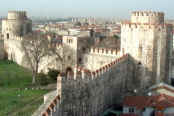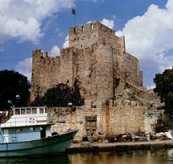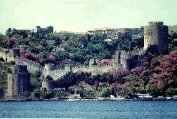
Latest News
New openings in 2025
The Zeyrek Cistern is opened to visits after years of restorations.
Entrance fees
As of 1st of March 2024, many State museums' fees are set in Euros, to be paid its equivalent in Turkish Liras.
Museum Pass
You can buy the "Museum Pass" for foreigners which is valid for 5 days in various museums of Istanbul.
Museums open 7 days
Many State museums in Istanbul operate 7 days a week, except Topkapi Palace.
Fortresses and Walls in Istanbul
Anadoluhisari (Anatolian Fortress)
A 14th century castle from the Ottoman's first attempt to capture Istanbul, Anatolian Fortress is located on the Asian shore of the city at the narrowest point of the Bosphorus Strait. Sultan Yildirim Bayezit built this fortress in 1395 on the ruins of an old temple dedicated to Zeus. The fortress is much smaller (7.000 m2 - 1,7 acres) in size when you compare it with Rumelihisari on the European side of Istanbul. Its towers are about 25 meters (82 feet) high with 2-5 meters (7-16 feet) tickness. The fortress was also named "Güzelce Hisar" in some historical documents. The fortress is recently restored and opened to the public in the end of 2023.
Open daily.
Anadoluhisari, Beykoz
Admission: 300 Turkish Liras
Rumelihisari (Rumeli Fortress)
Rumeli fortress was built by the sultan Mehmet the Conqueror in four months only and directly opposite to Anadoluhisari in 1452 in preparation for the final attack on Constantinople, which led to the downfall of the Byzantine Empire. The fortress is located at the narrowest section of the Bosphorus Strait (about 600 meters - 1970 feet). It occupies an area of 60.000 m2 (16 acres), had 4 main and 1 smaller gate, and 3 large and 1 smaller tower. From a small mosque inside, only its minaret survived. Rumelihisar suffered from big earthquakes but was always restored, final restoration was done in 1953 and opened as a museum. Today, the fortress is open to the public as an open-air museum and hosts many concerts and dramatic performances in its amphitheater usually during the summer months.
Open daily between 09:30-16:30 except Wednesdays.
Important note: some sections are closed for restorations.
Yahya Kemal Caddesi No:42, Rumelihisari - Sariyer
Tel: (212) 263 53 05
Admission: Euro 6, or its equivalent in Turkish Liras
Yedikule Hisari (Seven Towers dungeons)

As its name says in Turkish, Yedikule is a seven towered fortress which was built next to the city wall near the Byzantine Imperial Gate (Golden Gate or Porta Aurea) during the reign of Sultan Fatih Mehmet to protect the treasury. During the sultan Murat III's reign, the treasury was relocated to the Topkapi Palace and Yedikule began to be used as a dungeon. The place of imprisonment of many foreign ambassadors and Ottoman statesman, as well as a place of execution for some, the fortress was last used as a prison in 1831. It than became a dwelling for the lions of Topkapi Palace, and later a gunpowder manufacturing place. Today, the fortress is recently restored as a museum which is also hosting open air concerts in the inner courtyard during the summer months.
Osman Kale Meydani Caddesi No:4, Yedikule - Fatih
Sehir Surlari (City Walls)

Since the times of old Byzantium, a fortified city wall starting from the Golden Horn surrounded the city and reached the Sea of Marmara. But the land walls that we see today in Istanbul were built during the Byzantine period. First, Theodosius started to build a city wall in the 5th century AD than it was enlarged in the 6th century during the reign of Justinian because of the expansion of Constantinople. These walls were strong enough to stop enemy sieges such as Arab and Persian attacks in the 7th and 8th centuries but it couldn't stop the Ottoman army during the Conquest of Constantinople in the 15th century. During the Ottoman period, the wall was useless because Istanbul was in the middle of a huge Empire thus it was impossible for the enemy to capture all these lands until they could reach the city. Therefore the land walls were used as construction material and mostly destroyed because of the earthquakes. Today, some sections of the wall are being restored by the local municipality to remember its glorious times.
The Byzantine wall was divided into 3 sections: Marmara Sea walls, Golden Horn walls, and Land walls. The walls had over 300 big towers (20-25 meters - 65-82 feet high) for its defense and about 55 gates giving access to the city; 19 of them were at the Sea wall, 25 at the Golden Horn wall, and 11 at the Land wall. The city wall was about 22 kilometers in total, 9-12 meters (30-40 feet) high with 2-5 meters (7-16 feet) of tickness. There was a water canal in front of the land walls to stop any possible climb with ladders or digging a tunnel underneath.
Other castles
Other interesting old fortresses in Istanbul are Anadolu Kavagi Fortress and Rumeli Kavagi Fortress. Both of them were built during the Byzantine period at the entrance of the Bosphorus from the Black Sea, respectively on the Asian side (Anatolia) and on the European side (Thrace) of the city. These fortresses were also used during the Ottoman period to protect the Bosphorus Strait but than left in ruins.
You can check the Google Map of these Old Byzantine and Ottoman fortresses at this link.
Notes
Please note that admission fees, opening times or days of closure of the museums might be changed without prior notice, or that museum might be closed for restorations. To be certain on the closure days or opening times, you can call that museum directly (country code for Turkey is +90) or contact me to double check. Most of the museums have longer opening hours during summer months.
Hope to see you soon in Istanbul.



